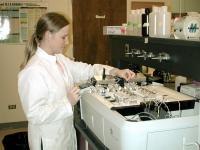Nov 24 2008
Agriculture producers may find they don't have to bottle their water from the Seymour Aquifer in the Rolling Plains to make it more valuable, according to Texas AgriLife Research scientists.
 Texas AgriLife Research technician Kathryn Bachman conducts analysis of water samples from the Seymour Aquifer for nitrate concentration at the Texas AgriLife Research and Extension Center at Vernon, Texas
Texas AgriLife Research technician Kathryn Bachman conducts analysis of water samples from the Seymour Aquifer for nitrate concentration at the Texas AgriLife Research and Extension Center at Vernon, Texas
Drs. John Sij, Cristine Morgan and Paul DeLaune have studied nitrate levels in irrigation water from the Seymour Aquifer for the past three years, and have found nitrates can be as high as 40 parts per million. Though unacceptable for drinking, the water would benefit agricultural producers who use it for irrigation.
This high concentration of nitrates is a concern because it exceeds the federal safe drinking water standards as the aquifer is used as a municipal water source for the communities of Vernon, Burkburnett and Electra, as well as some rural families, Sij said.
"When you get more than 10 parts per million, it exceeds the federal limit," he said. "Our water at Chillicothe is around 20 parts per million, so we don't give it to the babies, but adults can drink it."
Nitrate levels range from 3 parts per million to 40 parts per million in the aquifer, so the situation is being addressed by the Texas State Soil and Water Conservation Board, with grant funding from the Environmental Protection Agency.
Also working on the project are the Haskell, Wichita-Brazos and California Creek Soil and Water Conservation districts, the U.S. Department of Agriculture-Natural Resources Conservation Service, Texas AgriLife Extension Service, Texas A&M AgriLife's Texas Water Resources Institute, Rolling Plains Groundwater Conservation District and AgriLife Research.
"We don't know what percentage of the nitrate is geologic in nature or what percentage is due to farming operations," Sij said. "But if we take it into consideration in our fertility programs, we can mine the nitrogen and use it as a resource."
Mining the water for nitrates, instead of putting in additional and sometimes unnecessary nitrogen, may also have the potential to improve water quality from the Seymour Aquifer, he said.
Ninety percent of the water from the Seymour in Knox, Haskell, Baylor, Wichita, Wilbarger and Fisher counties is used for irrigation, he said. For those agricultural producers, it could be a source of nutrients that could reduce fertilizer costs.
"We encourage the installation of subsurface drip irrigation systems where possible," Sij said. This is thought to improve the water quality by reducing the nitrates, and to allow producers to realize the benefits of those nutrients supplied in the irrigation water.
Assuming a 20 parts per million nitrate concentration and just 12 inches of applied irrigation water per acre over the growing season, approximately 55 pounds of useable nitrogen per acre can be applied to a cotton crop, DeLaune said.
This amount of nitrogen exceeds the 50-pound requirement for a bale of cotton, Sij said. With drip irrigation, it can be put into the soil around the roots and not lost through denitrification as might occur through surface application of nitrogen.
Drip irrigation is a very efficient delivery system for nutrients, he said.
"At nearly a $1 per pound for fertilizer nitrogen these days, 55 'free' pounds of nitrogen can add up to significant cost savings, about $55 per acre or more, for producers who irrigate their crops with high nitrate ground water," DeLaune said.
The 150 pounds of nitrogen needed to grow three-bale cotton can be reduced if producers learn to take into account what is already in the soil and, now, what is in the water, he said.
"They need to know both those numbers before planning their fertilizer program," Sij said.
Of course, other nutrients like potassium and phosphorous must be adequate to take advantage of nitrates in the irrigation water as well as any applied fertilizer nitrogen, he said.
Producers should have their irrigation water analyzed for nitrate annually and make allowance for this free nitrogen source when determining crop fertilizer needs, Sij said.